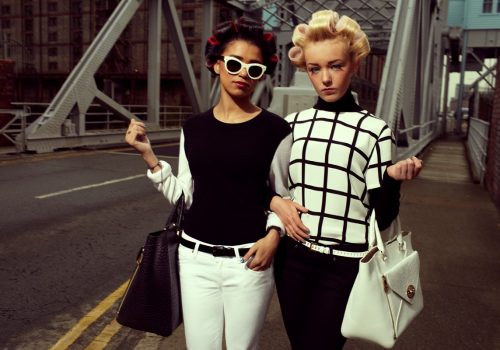Between history and fiction: the many faces of Northern England are on view in London.
Spread over ten exhibition rooms in the Somerset House in London, the exhibition North: Fashioning Identity explores the northern regions of the country through culture, fashion, and music. Displayed alongside items of clothing, magazines, videos, and documentary films, the photographs included in the exhibition examine authentic and fictional ways in which the image of the north has taken shape as well as the region’s geographic perimeters. Paved streets, brick façades, and abandoned industrial buildings are visual motifs that traverse historical periods and reduce the north to an abstract urban entity that is both creative and “dysfunctional.”
While you may have never been there, the culture of Northern England has no doubt made it to your home, is part of your music collection, and maybe even your wardrobe. The famous Doc Martens and flashy suspenders, as well as the Beatles, Oasis, and Arctic Monkeys, have contributed to popularizing English culture far beyond the country’s borders. Covering the period from the 1930s to Brexit, passing through de-industrialization, North: Fashioning Identity reviews socio-political contexts that have had an impact on English youth and its successive styles.
The years 1980–90 were a crucial decade in the country’s history: while the “Young Training Scheme” mandated by Margaret Thatcher was collapsing and unemployment skyrocketed, skinheads, rockers, “new romantics,” punks, and other “marginal” communities came together in mass protests in the streets of Manchester, Nottingham, Liverpool… The palpable tension was a fertile ground for nationalist and extreme-right movements. Documentary photographs of the period immortalize these young rebels who asserted their identity; they contribute to the construction of a political heritage and offer a diverse picture of the North.
Next to pieces of clothing and household objects, the photographs of the Thatcher era youth are confronted, or intermingled in this exhibition, with images from selected fashion magazines. The working-class environment, reduced to visual indices, stands in stark contrast to the showy glamor of the models. Whether it’s a glossy cover or a picture of street protests, the underlying representation of the English youth is studio photo and social performance. That’s not to mention the cinematographic quality that had shaped the North into a place at once emblematic and mysterious, celebrated by some and feared by others. Considering the hype surrounding its history and the diversity of cultural influences, what is the authentic picture of Northern England?
The composition of a visual and mental “picture” of the North is at the very heart of North: Fashioning Identity. In the last exhibition room, a bed and a living room are installed next to videos that incorporate Google Street View. As the visitor browses remote locations using household devices, the urban landscape has been filtered through Google camera. The private and the public, the “real” and the “performative” overlap and contrast. Revealing the fictional character of its content, the exhibition North: Fashioning Identity offers a plural picture of the North and examines the definition of the “truth.”
Julie Bonzon
Julie Bonzon is Ph.D. candidate in art history at the University College London (UCL) in the U.K.
North: Fashioning Identity
November 8 to February 4, 2018
Somerset House
South Wing, Strand
WC2R 1LA London
United Kingdom
















